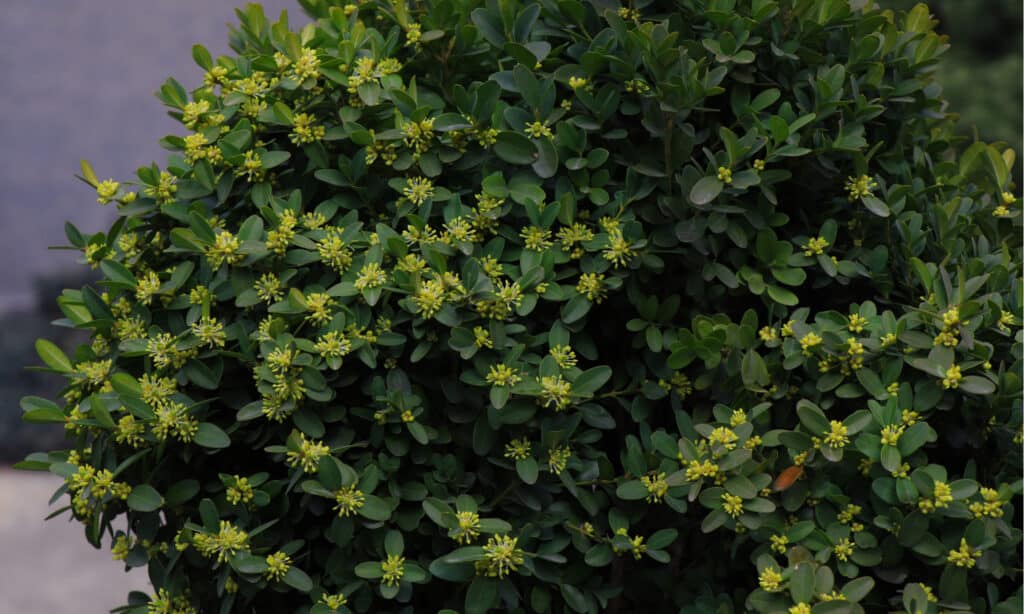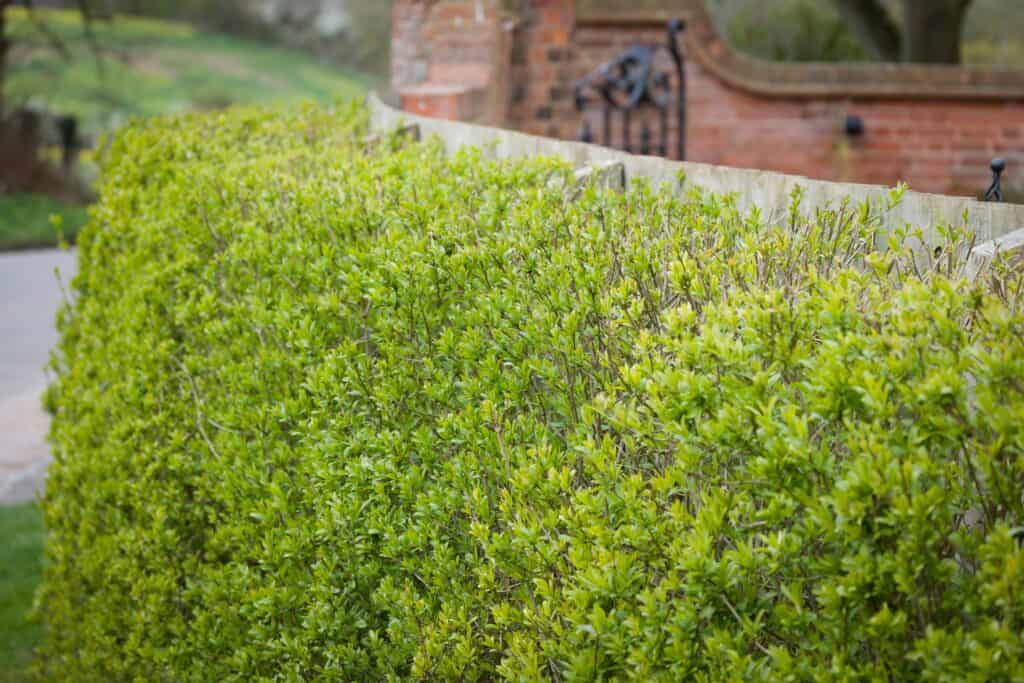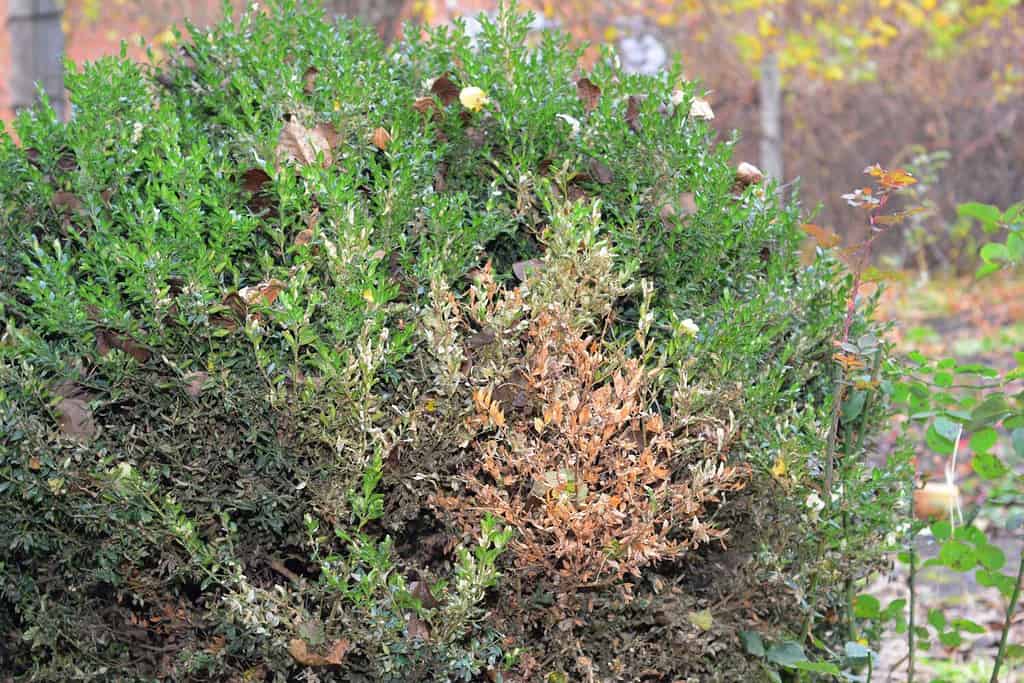Boxwood and privet are two very popular shrubs that are used in landscaping around the world. Not only are these two plants excellent for creating borders along properties, but they are also very attractive plants that add a touch of luxurious greenery to outdoor spaces.
Comparing privet and boxwood at first look seems really unusual because they are two entirely distinct plants with little in common. However, a lot is made evident if you think of them as hedge plants. Because they make for extremely comparable and appealing hedges, they are both frequently employed in landscaping.
In this article, we’ll explore all of the differences between privet shrubs and boxwood shrubs, so you can decide which plant will suit your landscaping project the best.
Comparing Privet vs. Boxwood
| Privet | Boxwood | |
|---|---|---|
| Classification | Ligustrum genus | Buxus genus |
| Alternative Names | Common Privet, Waxleaf, Amur, Wild Privet | Box Tree |
| Origin | Europe, North Africa, Southwestern Asia | Europe, Asia, North Africa, the Americas |
| Description | A genus of deciduous or evergreen shrubs that contains 50 different species. | A genus of evergreen shrubs with over 70 different cultivars and species. |
| Uses | Landscaping and hedging | Landscaping, hedging, topiary |
| Growth Tips | Grows best in full sun and partial shade in somewhat dry soil. | Grows well in partial shade and should be mulched regularly. |
| Interesting Features | Was used as a hedge shrub in Elizabethan gardens throughout England. | Most cultivars and species require little maintenance and are resistant to deer. |

The flowers of the boxwood shrub (pictured) are not considered as aesthetically pleasing as privet blooms for ornamental purposes.
©Antoniya Kadiyska/Shutterstock.com
The Key Differences Between Privet and Boxwood
The only real similarity between privet and boxwood is their use case as hedge shrubs in landscaping. When pruned in a similar manner, they can also look almost identical. Their light, soil, and water requirements are also similar. However, there are many differences between these two genera.
The size and growth rate are the key distinctions between privet and boxwood. Boxwood only grows eight inches per year, while privet can reach heights of two feet in a single year. As a result, in the same period of time, privet will be significantly bigger than boxwood.
Boxwood (also known as buxus) and privet (also known as ligustrum) are two distinct genera with numerous species each. They are both widespread all across the world, even in the United States. Boxwoods can grow in USDA hardiness zones 4 through 9, and privet shrubs can grow in zones 5 through 9. Boxwoods are therefore seen as more hardy than privets.
Although both privet and boxwood produce blooms, there is a very significant difference between the two. Tiny, unobtrusive, green-yellow blossoms adorn boxwood. In contrast to the young brightly-colored leaves, they are difficult to see. In April and May, the boxwood flowers. Flowers from boxwood are not particularly decorative or grown for their aesthetic appeal. Additionally, one of their drawbacks is the smell. It lacks strength and appeal.
On the other hand, privet shrubs have lovely white blossoms that are about an inch across. They stand out against the background of the foliage with clarity and are quite beautiful. The flowers develop in very substantial clusters, particularly if the plant has been frequently clipped.
These two plants’ leaves range greatly in size, color, and form. The leaves of a boxwood tree are about half an inch long and wide. Some cultivars have a bit bigger leaves, while others have even smaller ones. Privet leaves are at least one inch long. Thus, privet hedges are considered more lush and dense.

The wild privet or
ligustrum vulgare(pictured) is one of 50 species of the
ligustrumgenus that is used in landscaping.
©Paul Maguire/Shutterstock.com
Privet vs. Boxwood: Classification
Privet is a member of the ligustrum genus. This genus contains around 50 species of deciduous and evergreen shrubs, most of which are simply known as privet trees. Privet shrubs can come in a variety of species, such as the Chinese privet, Korean privet, common privet, and Amur privet.
Boxwood is a member of the buxus genus. This genus contains about 70 species of evergreen shrubs. Most members of this genus are collectively known as box or boxwood trees. Some species of boxwood include the Korean boxwood, European boxwood, and Vahl’s boxwood.
Privet vs. Boxwood: Description
Privets are flowering evergreen or deciduous plants that have terminal clusters of creamy-white, frequently odorous flowers, opposite, typically oval, smooth-margined leaves, and one to four seeded black berries. Although it is challenging to distinguish between privet species, doing so is typically unnecessary because they behave similarly in an environment and use the same pest management techniques. Despite being invasive, privet is still utilized in the landscaping industry.
The boxwood is an evergreen shrub with dense foliage. When left to grow on their own, the majority of boxwood species develop into big shrubs or small trees. Although the common boxwood can grow to a height of 30 feet, this is unusual in nature. It is a slow-growing shrub with several tiny, smooth-edged leaves that is thickly branching. They typically hang on the bush all winter and are dark green and glossy.
Privet vs. Boxwood: Uses
Today, privets are mostly employed in landscaping because they make great border shrubs and hedges. Privets are also employed in traditional medicine. Privet leaves or bark are used to make a decoction that can be used as a wash for skin issues, a treatment for diarrhea, stomach ulcers, persistent bowel issues, chapped lips, and painful mouths and throats. With their bitter qualities, privet leaves and bark can be used to make a tea that helps chemotherapy patients feel more satiated and improve their digestion.
Boxwood is excellent for carving and turning, but due to the tree’s small size, it can only be used for smaller projects. Carvings, musical instruments, handles, and other little specialty items are a few frequent uses for boxwood timber. However, boxwood shrubs are mostly utilized in landscaping as hedges or topiary plants.
Privet vs. Boxwood: Origin
Privet is a genus of shrubs and little trees native to southern and eastern Asia that can be found from the Himalayas to Australia. North Africa and a few regions of Europe both include some privet species.
Boxwood bushes are widespread around the world. They are thought to have originated in Europe, Asia, Northwest Africa, and the Americas. Egypt used boxwood for the first time about 4,000 B.C. The boxwood was cultivated by the Egyptians as formal hedges in their gardens.
Privet vs. Boxwood: How to Grow
Privet can be grown in sun or shade in moist but well-drained soil. In the first two years, make sure to give plants enough water and keep the area surrounding them weed-free. To keep your hedges in their traditional shape, prune once or twice a year. Before trimming, make sure to look carefully for bird nests.
It’s important to avoid planting too deeply while cultivating any type of boxwood. Boxwoods cannot tolerate moist soil, which results in root rot, which in turn causes dying and browning of the leaves. Their crown should be about one inch or so above the soil’s surface when they are planted. Boxwoods thrive in areas of dappled shadow where they receive full sun for a few hours each day.
Privet vs. Boxwood: Special Features
Privet can grow into a small tree or a large bush. Depending on the species or variation, it technically has a height range of 10 to 39 feet and a width range of four to eight feet. Privet species that are dwarf grow to a height of two to five feet. Late in the spring, often from April to June, privet blossoms. It is a member of the class of plants that induce allergies since it can make people with asthma or eczema more susceptible.
Spring is when boxwood shrubs start to flower. They are excellent pollinator plants because their blossoms draw bees and other insects. Boxwood spreads from cuttings and seeds. Depending on the species, boxwood is a perennial plant that can live between five to 600 years.
If you’re looking for a hedge plant with greater density and more fragrant flowers, the privet would be your best bet. However, if you need a hedge that is hardier in colder regions, boxwood would be the right choice. However, both of these hedges are quite hardy and aesthetically pleasing. Either one would make a great choice for your landscaping project.
Bonus: What is Boxwood Blight?

Mature plants can survive boxwood blight but will never look the same after pruning.
©Radovan1/Shutterstock.com
After reading this article you may be excited to purchase a boxwood for your yard or garden. Before purchasing from your local nursery or plant store you may want to ask if they have noticed any plants with boxwood blight.
Boxwood blight is a fungal disease that is easily transported in the nursery industry and can be transmitted to plants that show no sign of infection at the time they are shipped. It can be brought to you on a new boxwood plant or even by sprigs of boxwood in fresh Christmas wreaths or greenery. This disease was first seen in the U.S. in 2011 and has now been reported in more than 20 states and three Canadian provinces.
Symptoms begin as dark leaf spots that enlarge to form big brown blotches. The undersides of the infected leaves will show white spores following a period of high humidity. The disease causes rapid deterioration beginning on lower branches and moving up. The disease does not attack roots and more established plants could survive cutting the diseased parts off – but the plant will never look the same. Boxwood blight can live in soil for years – fungicides applied to newly infected plants offer the only hope. The disease affects American, English, Japanese and Korean boxwoods.
The photo featured at the top of this post is © iStock.com/coramueller
Sources
- NCSU (North Carolina State University), Available here: https://plants.ces.ncsu.edu/plants/buxus/
- NCSU (North Carolina State University), Available here: https://plants.ces.ncsu.edu/plants/ligustrum-vulgare/
- Ashley Downs and Erin Blain, Available here: https://www.bellarmine.edu/faculty/drobinson/Boxwood.htm
FAQs (Frequently Asked Questions)
Is privet better than boxwood?
Privet tends to resist drought better than boxwood, and it also grows a bit faster than boxwood. However, privet tends to shed more than boxwood.
How long does privet live?
In ideal conditions with excellent maintenance, privet hedges can easily live for up to 40 years.
How long does boxwood live?
When grown properly and well-cared for, most types of boxwood can live up to 30 years.
Thank you for reading! Have some feedback for us? Contact the AZ Animals editorial team.






